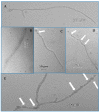Inner Leaf Gel of Aloe striata Induces Adhesion-Reducing Morphological Hyphal Aberrations
- PMID: 29419783
- PMCID: PMC5872326
- DOI: 10.3390/jof4010023
Inner Leaf Gel of Aloe striata Induces Adhesion-Reducing Morphological Hyphal Aberrations
Abstract
Fungi, particularly molds that are cosmopolitan in soils, are frequent etiologic agents of opportunistic mycoses. Members of the Fusarium solani and Fusarium oxysporum species complexes are the most commonly implicated etiologic agents of opportunistic fusarial infections in mammals, while Paecilomyces variotii is one of the most frequently encountered Paecilomyces species in human infections. Prevention and treatment of these mycoses are problematic because available antimycotics are limited and often have toxic side effects. Popular folk medicines, such as the inner leaf gel from Aloe spp., offer potential sources for novel antimycotic compounds. To screen for antifungal properties of Aloe striata, we treated conidia of three strains each of F. solani, F. oxysporum, and P. variotii with homogenized and filtered inner leaf gel. Exposure to gel homogenates caused minimal inhibition of conidial germination in tested strains. However, it significantly increased the frequency of hyphal aberrations characterized by increased hyphal diameters that resulted in intervals of non-parallel cell walls. Non-parallel cell walls ostensibly reduce total hyphal surface area available for adhesion. We found a significant decrease in the ability of aberrated P. variotii hyphae to remain adhered to microscope slides after repeated washing with reverse osmosis water. Our results suggest that treatment with A. striata contributes to a decrease in the adhesion frequency of tested P. variotii strains.
Keywords: Aloe; Aloe striata; Fusarium; Paecilomyces; aberrations; adhesion; antifungal; germination.
Conflict of interest statement
The authors declare no conflict of interest.
Figures




Similar articles
-
In vitro evaluation of the ovistatic and ovicidal effect of the cosmopolitan filamentous fungi isolated from soil on Ascaris suum eggs.Vet Parasitol. 2014 Jan 31;199(3-4):165-71. doi: 10.1016/j.vetpar.2013.10.026. Epub 2013 Nov 5. Vet Parasitol. 2014. PMID: 24295958
-
Fusarium oxysporum KB-3 from Bletilla striata: an orchid mycorrhizal fungus.Mycorrhiza. 2019 Oct;29(5):531-540. doi: 10.1007/s00572-019-00904-3. Epub 2019 Jul 3. Mycorrhiza. 2019. PMID: 31270609
-
Complexities associated with the molecular and proteomic identification of Paecilomyces species in the clinical mycology laboratory.Med Mycol. 2014 Jul;52(5):537-45. doi: 10.1093/mmy/myu001. Epub 2014 Mar 30. Med Mycol. 2014. PMID: 24687961
-
Final report on the safety assessment of AloeAndongensis Extract, Aloe Andongensis Leaf Juice,aloe Arborescens Leaf Extract, Aloe Arborescens Leaf Juice, Aloe Arborescens Leaf Protoplasts, Aloe Barbadensis Flower Extract, Aloe Barbadensis Leaf, Aloe Barbadensis Leaf Extract, Aloe Barbadensis Leaf Juice,aloe Barbadensis Leaf Polysaccharides, Aloe Barbadensis Leaf Water, Aloe Ferox Leaf Extract, Aloe Ferox Leaf Juice, and Aloe Ferox Leaf Juice Extract.Int J Toxicol. 2007;26 Suppl 2:1-50. doi: 10.1080/10915810701351186. Int J Toxicol. 2007. PMID: 17613130 Review.
-
Human fusariosis.Clin Microbiol Infect. 2004 Mar;10 Suppl 1:67-75. doi: 10.1111/j.1470-9465.2004.00845.x. Clin Microbiol Infect. 2004. PMID: 14748803 Review.
References
-
- O’Donnell K., Sutton D.A., Fothergill A., McCarthy D., Rinaldi M.G., Brandt M.E., Zhang N., Geiser D.M. Molecular phylogenetic diversity, multilocus haplotype nomenclature, and in vitro antifungal resistance within the Fusarium solani species complex. J. Clin. Microbiol. 2008;46:2477–2490. doi: 10.1128/JCM.02371-07. - DOI - PMC - PubMed
-
- Sahin G.O., Akova M. Emerging and life-threatening fungal pathogens in immunocompromised host. Eur. Oncol. Rev. 2005:1–4.
LinkOut - more resources
Full Text Sources
Other Literature Sources
Miscellaneous

